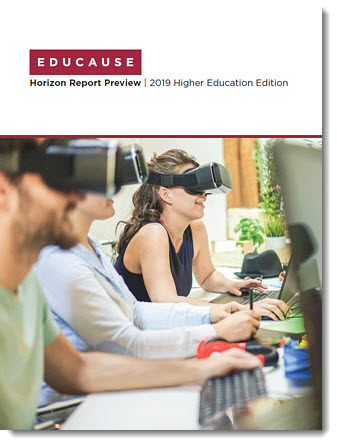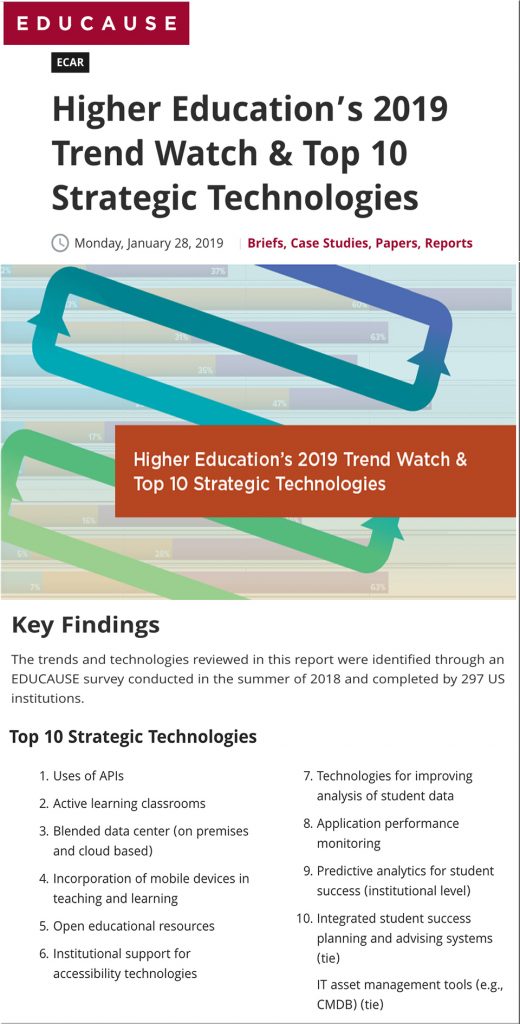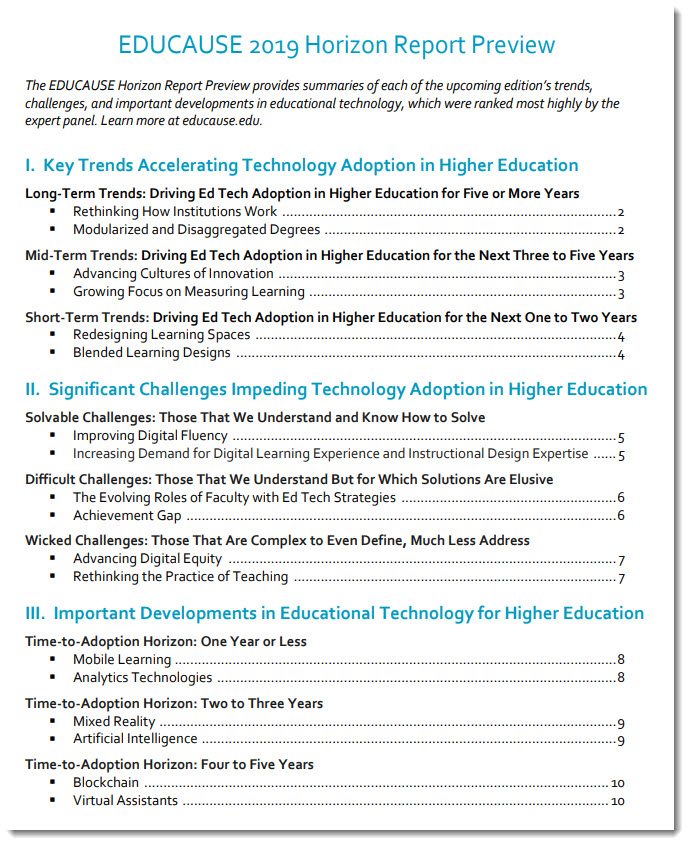
From DSC:
Is this only on Pixel 4? If so, too bad. It has a lot of potential — especially for students and lecture capture!
Speaking of lecture capture…Panopto offers an incredible search feature for searching text, audio, and video!
“With Panopto, you can search through your video library the same way you’d search across the internet, or through your email.
- By any keyword spoken in your videos
- By any word that ever appears on-screen or anywhere else in your video
- By traditional and advanced metadata, including tags and titles, viewer notes and comments, and even speakers notes from your PowerPoint slides.
- Panopto enables you to search across every video in your library…and get specific results that fast-forward to the exact moment the keyword occurs in your video.”
Top eLearning Gamification Companies 2019 — from elearningindustry.com by Christopher Pappas
Excerpt:
The Top Performing eLearning Gamification Companies 2019
As community leaders, here at eLearning Industry, we have evaluated hundreds of eLearning content development companies in the past. As we are constantly on the lookout for new advancements and trends in the eLearning field that are relevant to the industry, we decided to take a very close look at outstanding providers of gamification. We have focused on prestige, influence, application of gamification tools, activity in the eLearning field, gamification innovations, and many more subcategories.
For the list of the Top eLearning Gamification Companies 2019, we chose and ranked the best gamification companies based on the following 7 criteria:
- Gamification eLearning quality
- Customer reviews
- eLearning expertise
- Niche specialization on gamification
- Gamification industry innovation
- Company’s social responsibility
- Gamification features and capabilities
DIY Mindset Reshaping Education — from campustechnology.com by Dian Schaffhauser
Excerpt:
A do-it-yourself mindset is changing the face of education worldwide, according to new survey results. Learners are “patching together” their education from a “menu of options,” including self-teaching, short courses and bootcamps, and they believe that self-service instruction will become even more prevalent for lifelong learning. In the United Sates specifically, 84 percent of people said learning would become even more self-service the older they get.
Among those who have needed to reskill in the last two years to continue doing their jobs, 42 percent found information online and taught themselves and 41 percent took a course or training offered by their employers, a professional association or bootcamp, compared to just 28 percent who pursued a professional certification program, 25 percent who enrolled in a university-level degree program or 12 percent who did nothing.
If people had to learn something new for their career quickly, they said they would be more likely turn to a short training program (47 percent), followed by access to a free resource such as YouTube, Lynda.com or Khan Academy (33 percent). A smaller share (20 percent) would head to an accredited university or college.
From DSC:
This is why the prediction from Thomas Frey carries weight and why I’ve been tracking a new learning platform for the 21st century. Given:
- The exponential pace of technological change occurring in many societies throughout the globe

- That emerging technologies are game-changers in many industries
- That people will need to learn about those emerging technologies and how to leverage/use them <– if they want to remain marketable/employed
- That people need to reinvent themselves quickly, efficiently, and cost-effectively
- That many people can’t afford the time nor the funding necessary these days to acquire a four-year higher ed degree
- That running new courses, programs, etc. through committees, faculty senates, etc. takes a great deal of time…and time is something we no longer have (given this new pace of change)
…there needs to be a new, up-to-date, highly responsive, inexpensive learning-related platform for the 21st century. I call this learning platform of the future, “Learning from the Living [Class] Room.” And while it requires subject matter experts / humans in significant ways, AI and other technologies will be embedded throughout such a platform.
“I’ve been predicting that by 2030 the largest company on the internet is going to be an education-based company that we haven’t heard of yet,” Frey, the senior futurist at the DaVinci Institute think tank, tells Business Insider.
— source
Addendum on 9/18/19:
- Education Startup Launches Online Courses for College Credit — from campustechnology.com by Sara Friedman
For $400 per course, students will be able to gain access to course videos that are cinematically filmed and taught by “some of the brightest minds in academia.” Outlier.org students will also have access to problem sets, one-on-one tutoring and assessments proctored through artificial intelligence.
Screen Mirroring, Screencasting and Screen Sharing in Higher Education — from edtechmagazine.com by Derek Rice
Digital learning platforms let students and professors interact through shared videos and documents.
Excerpt (emphasis DSC):
Active learning, collaboration, personalization, flexibility and two-way communication are the main factors driving today’s modern classroom design.
Among the technologies being brought to bear in academic settings are those that enable screen mirroring, screencasting and screen sharing, often collectively referred to as wireless presentation solutions.
These technologies are often supported by a device and app that allow users, both students and professors, to easily share content on a larger screen in a classroom.
“The next best thing to a one-to-one conversation is to be able to share what the students create, as part of the homework or class activity, or communicate using media to provide video evidence of class activities and enhance and build out reading, writing, speaking, listening, language and other skills,” says Michael Volpe, marketing manager for IOGEAR.
Google brings AI to studying with Socratic — from zdnet.com by Stephanie Condon
Ahead of the new school year, Google is re-launching a mobile learning app it acquired last year.
Excerpt:
Google this week started rolling out a revamped version of a mobile learning app, called Socratic, that the tech giant acquired last year. The updated app, with new machine learning-powered features, coincides with the start of the school year, as well as other Google for Education initiatives.
Socratic aims to help both high school and university students in their studies outside of the classroom. If students need help answering a study question, they can now use the Socratic app to ask a question with their voice, or to take a picture of a question in their study materials. The app will then find relevant material from across the web.
Also see:
- The School of Tomorrow Will Revolve Around AI — from datafloq.com
Excerpt:
We live in exponential times, and merely having a digital strategy focused on continuous innovation is no longer enough to thrive in a constantly changing world. To transform an organisation and contribute to building a secure and rewarding networked society, collaboration among employees, customers, business units and even things is increasingly becoming key.Especially with the availability of new technologies such as artificial intelligence, organisations now, more than ever before, need to focus on bringing together the different stakeholders to co-create the future. Big data empowers customers and employees, the Internet of Things will create vast amounts of data and connects all devices, while artificial intelligence creates new human-machine interactions. In today’s world, every organisation is a data organisation, and AI is required to make sense of it all.
Addendum on 8/23/19
- Google: Gmail’s new AI spelling, grammar checks help you avoid email blunders — from zdnet.com by Liam Tung
Gmail on G Suite gains new AI-assisted spellcheck and grammar features.
Pearson moves away from print textbooks — from campustechnology.com by Rhea Kelly
Excerpt:
All of Pearson’s 1,500 higher education textbooks in the U.S. will now be “digital first.” The company announced its big shift away from print today, calling the new approach a “product as a service model and a generational business shift to be much more like apps, professional software or the gaming industry.”
The digital format will allow Pearson to update textbooks on an ongoing basis, taking into account new developments in the field of study, new technologies, data analytics and efficacy research, the company said in a news announcement. The switch to digital will also lower the cost for students: The average e-book price will be $40, or $79 for a “full suite of digital learning tools.”
“Interesting new trends such as #AR , location-based technology, and micro-assessments have invaded the mobile learning space too. Here’s an infographic that gives you information on the latest trends in mobile learning.”https://t.co/M9FEM4PCkh
— Daniel Christian (@dchristian5) June 30, 2019
Do you have a virtual personal assistant? With #VoiceAssistants we might get time back to do what we want to do. Tech giants believe that voice is as big as touchscreen and will invest a lot in the further development. #Microsoft #Google https://t.co/uPqkKyiPT3 pic.twitter.com/IjeVn5Af4p
— Wynter (@WynterElwood) June 17, 2019
Also see:
Microsoft is building a virtual assistant for work. Google is building one for everything else — from qz.com by Dave Gershgorn
Excerpts:
In the early days of virtual personal assistants, the goal was to create a multipurpose digital buddy—always there, ready to take on any task. Now, tech companies are realizing that doing it all is too much, and instead doubling down on what they know best.
…
Since the company has a deep understanding of how organizations work, Microsoft is focusing on managing your workday with voice, rearranging meetings and turning the dials on the behemoth of bureaucracy in concert with your phone.
Voice is the next major platform, and being first to it is an opportunity to make the category as popular as Apple made touchscreens. To dominate even one aspect of voice technology is to tap into the next iteration of how humans use computers.
From DSC:
What affordances might these developments provide for our future learning spaces?
Will faculty members’ voices be recognized to:
- Sign onto the LMS?
- Dim the lights?
- Turn on the projector(s) and/or display(s)?
- Other?
Will students be able to send the contents of their mobile devices to particular displays via their voices?
Will voice be mixed in with augmented reality (i.e., the students and their devices can “see” which device to send their content to)?
Hmmm…time will tell.
9 amazing uses for VR and AR in college classrooms — from campustechnology.com by Dian Schaffhauser
Immersive technologies can help students understand theoretical concepts more easily, prepare them for careers through simulated experiences and keep them engaged in learning.
Excerpt:
Immersive reality is bumping us into the deep end, virtually speaking. Colleges and universities large and small are launching new labs and centers dedicated to research on the topics of augmented reality, virtual reality and 360-degree imaging. The first academic conference held completely in virtual reality recently returned for its second year, hosted on Twitch by Lethbridge College in Alberta and Centennial College in Toronto. Majors in VR and AR have begun popping up in higher education across the United States, including programs at the Savannah School of Design (GA), Shenandoah University (VA) and Drexel University Westphal (PA). Educause experts have most recently positioned the timing for broad adoption of these technologies in education at the two-year to three-year horizon. And Gartner has predicted that by the year 2021, 60 percent of higher education institutions in the United States will “intentionally” be using VR to create simulations and put students into immersive environments.
If you haven’t already acquired your own headset or applied for a grant from your institution to test out AR or VR for instruction, it’s time. We’ve done a scan of some of the most interesting projects currently taking place in American classrooms to help you imagine the virtual possibilities.
The finalized 2019 Horizon Report Higher Education Edition (from library.educause.edu) was just released on 4/23/19.
Excerpt:
Key Trends Accelerating Technology Adoption in Higher Education:
Short-Term—Driving technology adoption in higher education for the next one to two years
- Redesigning Learning Spaces
- Blended Learning Designs
Mid-Term—Driving technology adoption in higher education for the next three to five years
- Advancing Cultures of Innovation
- Growing Focus on Measuring Learning
Long-Term—Driving technology adoption in higher education for five or more years
- Rethinking How Institutions Work
- Modularized and Disaggregated Degrees
From a fairly recent e-newsletter from edsurge.com — though I don’t recall the exact date (emphasis DSC):
New England is home to some of the most famous universities in the world. But the region has also become ground zero for the demographic shifts that promise to disrupt higher education.
This week saw two developments that fit the narrative. On Monday, Southern Vermont College announced that it would shut its doors, becoming the latest small rural private college to do so. Later that same day, the University of Massachusetts said it would start a new online college aimed at a national audience, noting that it expects campus enrollments to erode as the number of traditional college-age students declines in the coming years.
“Make no mistake—this is an existential threat to entire sectors of higher education,” said UMass president Marty Meehan in announcing the online effort.
The approach seems to parallel the U.S. retail sector, where, as a New York Times piece outlines this week, stores like Target and WalMart have thrived by building online strategies aimed at competing with Amazon, while stores like Gap and Payless, which did little to move online, are closing stores. Of course, college is not like any other product or service, and plenty of campuses are touting the richness of the experience that students get by actually coming to a campus. And it’s not clear how many colleges can grow online to a scale that makes their investments pay off.
“It’s predicted that over the next several years, four to five major national players with strong regional footholds will be established. We intend to be one of them.”
University of Massachusetts President Marty Meehan
From DSC:
That last quote from UMass President Marty Meehan made me reflect upon the idea of having one or more enormous entities that will provide “higher education” in the future. I wonder if things will turn out to be that we’ll have more lifelong learning providers and platforms in the future — with the idea of a 60-year curriculum being an interesting idea that may come into fruition.
Long have I predicted that such an enormous entity would come to pass. Back in 2008, I named it the Forthcoming Walmart of Education. But then as the years went by, I got bumbed out on some things that Walmart was doing, and re-branded it the Forthcoming Amazon.com of Higher Education. We’ll see how long that updated title lasts — but you get the point. In fact, the point aligns very nicely with what futurist Thomas Frey has been predicting for years as well:
“I’ve been predicting that by 2030 the largest company on the internet is going to be an education-based company that we haven’t heard of yet,” Frey, the senior futurist at the DaVinci Institute think tank, tells Business Insider. (source)
I realize that education doesn’t always scale well…but I’m thinking that how people learn in the future may be different than how we did things in the past…communities of practice comes to mind…as does new forms of credentialing…as does cloud-based learner profiles…as does the need for highly efficient, cost-effective, and constant opportunities/means to reinvent oneself.
Also see:
- Fearing ‘existential threat,’ U of Massachusetts unveils plans for national online platform — from educationdive.com by Natalie Schwartz
Addendum:
74% of consumers go to Amazon when they’re ready to buy something. That should be keeping retailers up at night. — from cnbc.com
Key points (emphasis DSC)
- Amazon remains a looming threat for some of the biggest retailers in the country — like Walmart, Target and Macy’s.
- When consumers are ready to buy a specific product, nearly three-quarters of them, or 74 percent, are going straight to Amazon to do it, according to a new study by Feedvisor.
- By the end of this year, Amazon is expected to account for 52.4 percent of the e-commerce market in the U.S., up from 48 percent in 2018.
“In New England, there will be between 32,000 and 54,000 fewer college-aged students just seven years from now,” Meehan said. “That means colleges and universities will have too much capacity and not enough demand at a time when the economic model in higher education is already straining under its own weight.” (Marty Meehan at WBUR)
Higher Education’s 2019 Trend Watch & Top 10 Strategic Technologies — from EDUCAUSE Center for Analysis and Research (ECAR)
Most Influential Trends
- Growing complexity of security threats
- Student success focus/imperatives
- Data-driven decision-making
- Increasing complexity of technology, architecture, and data
- Contributions of IT to institutional operational excellence
- Each of these trends is influential at 63% or more of colleges and universities. And, they are enduring—these are the same trends that exerted the most influence on IT strategy in 2018.
4 key tech strategies for the survival of the small liberal arts college — from campustechnology.com by Kellie B. Campbell
In a recent study on the use of technology to reduce academic costs in liberal arts colleges, four distinct themes emerged: the strategic role of IT; the importance of data; the potential of alternative education delivery modes; and opportunities for institutional partnerships. Here’s how IT leaders at these small colleges understand the future of their institutions.
Excerpt:
In this study, the flexibility of the semi-constructed interview format resulted in a fascinating level of honesty and bluntness from participants. In particular, participants’ language changed when they were asked to take off their professional hat and consider a new point of view — it was a chance to be vulnerable and honest. What was probably most interesting was that almost everyone signaled that the status quo is not sustainable. Something in the higher education model has to change for institutions to stay open, yet many lack a strategy for effecting change. Even if they do have a strategy in place on the business side, many are hesitant to dive into analysis and change on the academic side of the institution.
Institutions simply cannot continue to nibble at the edges of change. Significant change is needed in order to sustain the financial model of higher education. The ideas for doing so are out there, though the work must be guided by the institutional mission and consider new models for delivering education. CIOs and their departments can play an important role in that work — providing infrastructure, data, access, services and ideas — but institutional leadership at large needs to understand IT’s strategic role and position the organization to make that impact.
When participants were able to think about the “what if” question — what if the institution were forced to drastically cut academic costs — several had detailed, “out there” ideas that might not be traditionally welcomed into higher education cultures. Yet a number of participants were not being asked by their institutions to think about such ideas. The question is, if everyone agrees that the status quo is not sustainable, why aren’t they thinking about it?
Horizon Report Preview 2019 — from library.educause.edu
Analytics, Artificial Intelligence (AI), Badges and Credentialing, Blended Learning, Blockchain, Digital Learning, Digital Literacy, Extended Reality (XR), Instructional Design, Instructional Technologies, Learning Analytics, Learning Space, Mobile Learning, Student Learning Support, Teaching and Learning
Abstract
The EDUCAUSE Horizon Report Preview provides summaries of each of the upcoming edition’s trends, challenges, and important developments in educational technology, which were ranked most highly by the expert panel. This year’s trends include modularized and disaggregated degrees, the advancing of digital equity, and blockchain.
For more than a decade, EDUCAUSE has partnered with the New Media Consortium (NMC) to publish the annual Horizon Report – Higher Education Edition. In 2018, EDUCAUSE acquired the rights to the NMC Horizon project.















